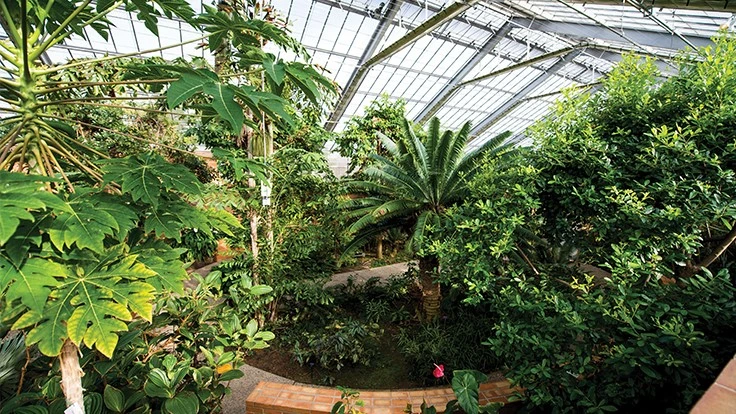
Photo courtesy of the Conservatory at Matthaei Botanical Gardens

WHY THEY’RE GREAT: The Conservatory at Matthaei Botanical Gardens at University of Michigan in Ann Arbor, Michigan, is home to more than 1,000 different plant species from across the globe. And while there are research greenhouses at the facility, the Conservatory’s primary mandate is to grow plants that other programs at the university use in their own research. According to Dr. David Michener, the university services curator and manager for the Conservatory, all but one of UM’s 17 colleges utilize plants grown and housed in the conservatory. It produces plants in three different houses — an arid house, a temperate house and a tropical house — to meet specific plant needs.
“One hundred percent of what we grow has to be justified for education,” Michener says, “but it could be for art, engineering, tropical botany or whatever else. It makes it really interesting.”
Ann Arbor residents, UM students and out-of-town visitors can stop by the Conservatory to see unique plants, as it is open to the public most of the time.
19th CENTURY ORIGINS: Although the conservatory building itself was built in 1964, the efforts to grow plants for research predate World War I.
“This started as a pharmaceutical collection back in the 1800s,” Michener says. “When the first greenhouse was built back around World War I, it was just used to keep the plants needed for the pharmacy and medical students alive.” At that time, he says, hundreds of different plants were being grown and slowly expanded as more university programs required plants.

In the early 20th century, before air travel became accessible, Michener says the conservatory was necessary to grow plants needed for research that would otherwise take months or years to procure.
CONSIDERING THE FUTURE: One of the major projects the conservatory will be working on in 2019 and in the years to come is finding plants that have been negatively affected by climate change, Michener says. He notes that the plants could come anywhere in the world, as long as they still meet the university requirement of aiding research efforts.
“This is the future — finding plants that are in really unique environments and need care,” Michener says.
In order to select new plants, Michener says he works with the growing team and determines how the plants in the greenhouses need to be cared for and/or if there are any plants that are no longer needed that can be removed from the conservatory. He also considers requests from different programs at the university for specific plants and determines if growing them is both viable in the greenhouses and will provide value to the university. Many of the plants are donated from collections in the United States, but many come from overseas too.
“It’s a really high-stakes dance — a horticultural dance,” Michener says. “And because we are open to the public so much, we want plants that tell a story about pollinators or fruit dispersal that interests people. We have to present these plants and make them look great.”

Explore the January 2019 Issue
Check out more from this issue and find your next story to read.
Latest from Greenhouse Management
- Anthura acquires Bromelia assets from Corn. Bak in Netherlands
- Top 10 stories for National Poinsettia Day
- Langendoen Mechanical hosts open house to showcase new greenhouse build
- Conor Foy joins EHR's national sales team
- Pantone announces its 2026 Color of the Year
- Syngenta granted federal registration for Trefinti nematicide/fungicide in ornamental market
- A legacy of influence
- HILA 2025 video highlights: John Gaydos of Proven Winners





